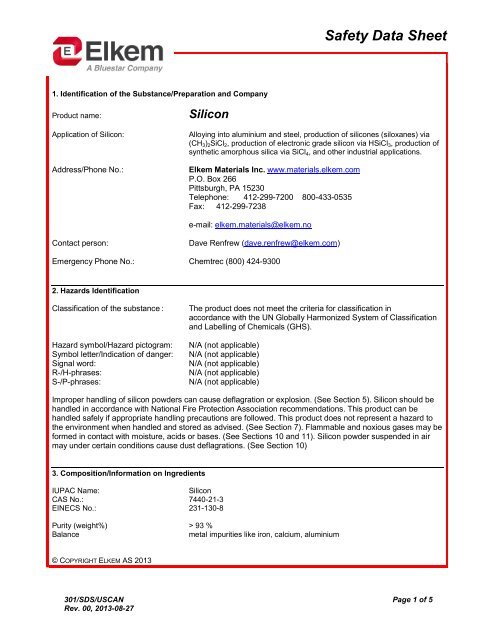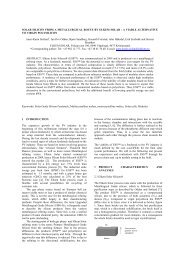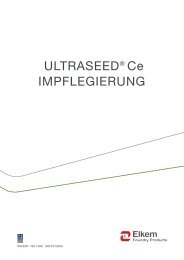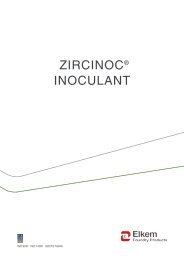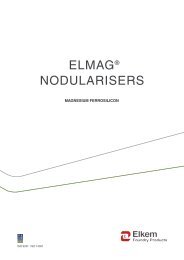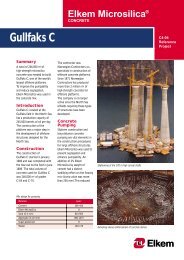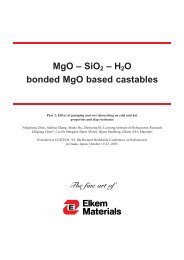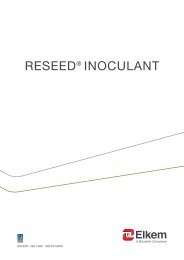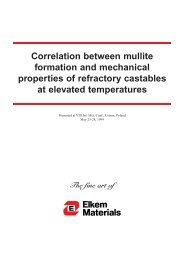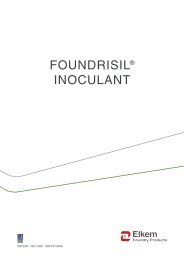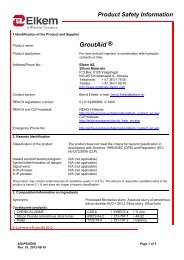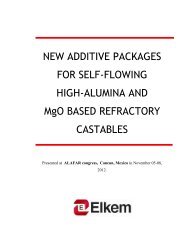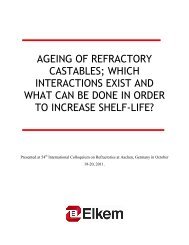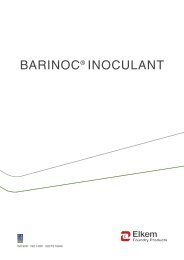Safety Data Sheet - Elkem
Safety Data Sheet - Elkem
Safety Data Sheet - Elkem
Create successful ePaper yourself
Turn your PDF publications into a flip-book with our unique Google optimized e-Paper software.
Occupational Exposure Limits (OSHA 29 CFR 1910.1000 TABLE Z-1 and ACGIH 1), 2013):8hr TWA (mg/m 3 )OSHA PELACGIH TLVSilicon 15 (total) 10 (inhalable, PNOS 2) )5 (respirable) 3 (respirable, PNOS 2) )1) American Conference of Governmental Industrial Hygienists2) Particulates (Insoluble or Poorly Soluble) Not Otherwise Specified. Silicon is considered to be PNOS. SpecificTLVs for the individual substances have not been established or have been withdrawn, respectively.9. Physical and Chemical PropertiesStructure: CrystallineForm: Lump material.Colour: Silvery material.Odour: Odourless.Solubility (Water): Insoluble/slightly soluble.Melting Point (°C) : Approx. 1410Boiling Point (°C) : Approx. 2355Specific Gravity (water = 1) : Approx. 2.310. Stability and ReactivitySilicon is insoluble in most acids, but dissolves in a mixture of hydrofluoric acid (HF) and nitric acid (HNO 3 ) evolvinghazardous gases. Impurities present in silicon (e.g. Al and Ca) may react with dilute acids evolving hazardous gases(see below).Silicon dissolves readily in dilute lye.Conditions to avoid:Avoid generating sparks or other ignition sources (e.g. welding) in areas with high dust concentrations.Silicon-particles suspended in air at concentrations above 100 g/m 3 can cause dust explosions. Bothignition sensitivity and the violence of explosion increase with decreasing particle size. Silicon dust withparticle diameter > 40 µm probably entails no danger of explosion.Ignition temperature (warm surface) ≥ 800 °C.Addition of wet material to molten silicon may cause explosions.Materials to avoid:Acids (see below).Hazardous decomposition products:A reaction with hydrofluoric acid (HF) and nitric acid (HNO 3 ) leads to the formation of toxic gases such assilicon tetrafluoride (SiF 4 ) or nitrous gases (NO x ). Impurities in silicon may react with dilute acids formingflammable and harmful gases such as hydrogen (H 2 ) and silane (SiH 4 ).Wet product will form flammable hydrogen gas if added to molten silicon, due to decomposition of water.301/SDS/USCAN Page 3 of 5Rev. 00, 2013-08-27
11. Toxicological InformationThe product does not meet the criteria for classification in accordance with the UN Globally HarmonizedSystem of Classification and Labelling of Chemicals (GHS).Acute effects:Inhalation:Skin contact:Eye contact:Ingestion:Dust may irritate and dehydrate mucous membranes.Dust may irritate and dehydrate skin.Dust may irritate and lead to dryness.Dust may irritate and dehydrate mucous membranes.Chronic effects:No chronic effects known.12. Ecological InformationThe product is not characterised as dangerous for the environment.MOBILITY:The substance has poor mobility under normal environmental conditions.PERSISTENCE: Not relevant for metalloids.BIOACCUMULATION: Not relevant, due to low mobility and non-dispersive use.ECO-TOXICITY: The product does not meet the classification criteria for ecotoxicological endpoints inaccordance with the UN Globally Harmonized System of Classification and Labelling ofChemicals (GHS).13. Disposal ConsiderationsAvoid repackaging wet material in sealed containers. Dispose of in accordance withapplicable federal, state, and local regulations. Recycle materials when possible.Silicon is not a listed RCRA Hazardous Wastes (40 CFR 261).14. Transport InformationUN no.IMDG-Code:ICAO/IATA:ADR/RID:None.Not subject to classification.Not subject to classification.Not subject to classification.DOT (DEPARTMENT OF TRANSPORTATION):Proper Shipping Name: Not RegulatedI.D. Number and Initials: Not RegulatedPacking Group: Not RegulatedLabel(s): Not RegulatedThe product described in this SDS has an elemental crystalline structure and is not amorphous. <strong>Elkem</strong> hasdetermined its silicon producdts do not smolder or propagate flames when tested according to 49CFR 173.125and should not be considered Division 4.1 flammable solids.301/SDS/USCAN Page 4 of 5Rev. 00, 2013-08-27
15. Regulatory InformationA chemical safety assessment (CSA) has been carried out for the substance in accordance with the EuropeanRegulation (EC) 1907/2006 (REACH).OSHA:This safety data sheet has been compiled in accordance with the revised HazardCommunication Standard (HCS 2012) and applies GHS classification criteria.Amorphous silica fume and Silicon Carbide can be considered a nuisance dust and are assuch outside the scope of the revised HCS (29 CFR 1910.1200 section (b)(6)(x)).TSCA (Toxic Substance Control Act):The product is listed on the TSCA Inventory: ID 14916, CAS # 7440-21-3 (silicon)CERCLA (Comprehensive Response Compensation, and Liability Act):Silicon is not listed in 40 CFR 302.4.RCRA (Resource Conservation/Recovery Act):Silicon is not a listed hazardous waste.SARA TITLE III (Superfund Amendments and Reauthorization Act):311/312 Hazard Categories:Immediate Health, Delayed Health, Fire.313 Reportable Ingredients:NoneCALIFORNIA PROPOSITION 65:This product contains chemical(s) known to the State of California to cause cancer:NoneIARC (International Agency for Research on Cancer):Not listed.US-NTP (US National Toxicology Progam):The product is not listed in the 2011 Report on Carcinogens (RoC).WHMIS (Workplace Hazardous Materials Information System):not classified.DSL Canada (Domestic Substances List):Silicon is specified on the public Portion of the Domestic Substances List.16. Other InformationAccording to Chapter 1.5.2 of the UN Globally Harmonized System of classification and labelling of chemicals(GHS) safety data sheets (SDS) are only required for substances and mixtures that meet the harmonizedcriteria for physical, health or environmental hazards. This product does not meet these criteria.Legal Disclaimer:The information given in this sheet is to the best of <strong>Elkem</strong>’s knowledge and believed accurate and reliable asof the date indicated. However, no representation, warranty or guarantee is made to its accuracy, reliability orcompleteness. It is the user’s responsibility to satisfy himself as to the suitability and completeness of suchinformation for his own particular use.Literature references are available upon request.301/SDS/USCAN Page 5 of 5Rev. 00, 2013-08-27


